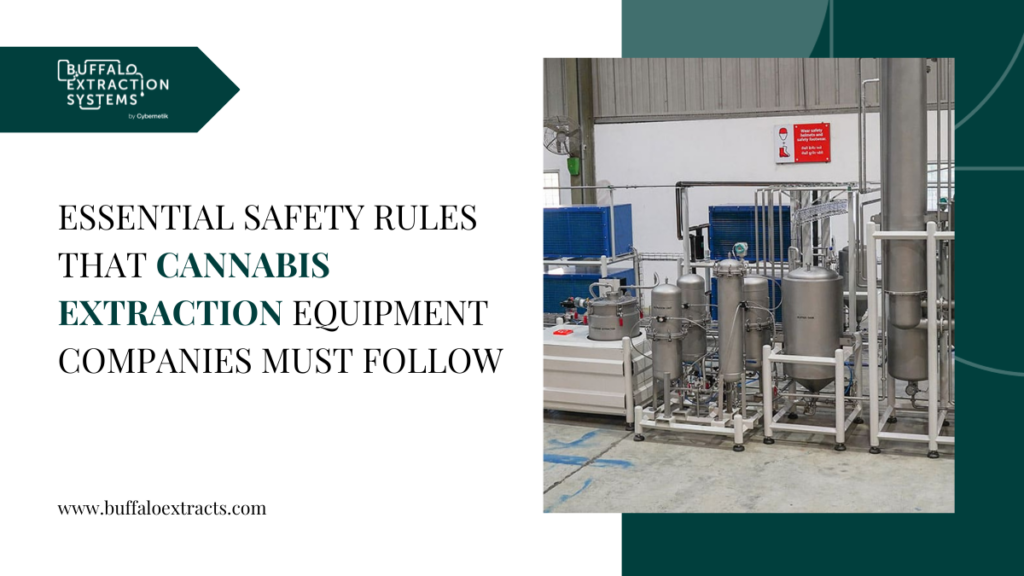Ensuring Safety in Cannabis Extraction Equipment Companies
Safety is the absolute cornerstone in the dynamic and expanding cannabis industry, particularly when it comes to companies specializing in extraction equipment. With an escalating demand for cannabis extracts, there is an inherent need for rigorous safety measures to shield both the workforce and the environment from potential hazards.
This article details the essential safety rules that cannabis extraction equipment companies must follow. From navigating the intricacies of regulatory compliance to the critical aspects of employee training and the development of robust emergency response plans, each element plays a pivotal role in establishing a secure working environment.

As the medical cannabis extraction landscape evolves, adherence to these safety protocols becomes not just a regulatory obligation but a crucial commitment to the overall integrity of the cannabis extraction process. Following are some essential safety rules that cannabis extraction equipment companies must follow:
- Compliance with Regulations: Cannabis extraction equipment companies must strictly adhere to local, state, and federal regulations governing the cannabis industry. These regulations outline specific safety standards, licensing requirements, and operating procedures to ensure the safe extraction of cannabinoids.
- Employee Training: Proper training for employees is critical to minimize the risks associated with cannabis extraction. All personnel involved in the extraction process should receive comprehensive training on equipment operation, emergency procedures, and the handling of hazardous materials.
- Facility Design and Layout: The layout of the extraction facility should be designed with safety in mind. Adequate spacing between cannabis oil extraction equipment, emergency exits, and designated safety zones are essential to prevent accidents and facilitate a swift response in case of emergencies.
- Equipment Inspection and Maintenance:Regular inspection and maintenance of extraction equipment are imperative to identify and address potential safety hazards. Companies must establish a routine maintenance schedule, including CO2 extraction equipment testing and calibration. This ensures optimal performance and minimize the risk of malfunctions.
- Personal Protective Equipment (PPE): All employees involved in the medical cannabis extraction process must wear appropriate personal protective equipment, including but not limited to gloves, safety goggles, lab coats, and respiratory protection. PPE safeguards workers from exposure to hazardous chemicals, and ensures a safer working environment.
- Ventilation Systems: Adequate ventilation is crucial to prevent the accumulation of volatile gases and solvents in the extraction facility. Installing effective ventilation systems helps maintain air quality and reduces the risk of flammable or harmful vapors from reaching hazardous levels.
- Fire Safety Measures: Implementing robust fire safety measures is essential given the potential for some of the flammable solvents in the extraction process. This includes the installation of fire suppression systems, fire extinguishers, and clear evacuation protocols. Regular fire drills should also be conducted to ensure employees are familiar with emergency procedures.
- Chemical Handling and Storage: Proper storage and handling of extraction solvents and chemicals are paramount. Companies must follow strict protocols for the storage, labeling, and disposal of hazardous materials. Material Safety Data Sheets (MSDS) should be readily available, detailing the properties and safety considerations of each chemical used.
- Emergency Response Plans: Cannabis extraction equipment companies must have well-defined emergency response plans in place. These plans should cover a range of potential incidents, including fires, chemical spills, and equipment malfunctions. Regular training and drills are essential to ensure that employees can respond effectively in emergencies.
- Quality Control and Testing: Implementing stringent quality control measures is essential to guarantee the purity and safety of the extracted cannabinoids. Regular testing for residual solvents, contaminants, and potency ensures that the final product meets regulatory standards and poses no health risks to consumers.
- Documentation and Record Keeping: Thorough documentation of all extraction processes including supercritical CO2 extraction process, safety procedures, and employee training is crucial for regulatory compliance. Companies should maintain detailed records to demonstrate their commitment to safety and adherence to industry regulations.
- Risk Assessments: Conducting comprehensive risk assessments is a proactive measure to identify potential hazards in the extraction process. Regularly reviewing and updating risk assessments allows companies to adapt safety protocols to changes in Cannabis oil extraction equipment, processes, or regulations.
- Communication Protocols: Establishing clear communication protocols among employees is vital for maintaining a safe work environment. Effective communication ensures that all team members are aware of safety procedures, emergency protocols, and any changes in operating processes.
- Continuous Improvement: Cannabis extraction equipment companies should foster a culture of continuous improvement in safety practices. Regularly reviewing and updating safety protocols based on lessons learned from incidents, industry advancements, or regulatory changes is essential to staying at the forefront of safety standards.
Finally
In this rapidly transforming cannabis industry, essential safety rules that cannabis extraction equipment companies must follow are an indispensable and non-negotiable priority. By steadfastly adhering to the fundamental safety rules delineated in this guide, these companies can not only meet regulatory standards but also establish resilient protocols that safeguard employees and contribute to the responsible growth of the cannabis sector.
Continuous dedication to safety, coupled with ongoing employee training initiatives and a commitment to best practices, doesn’t just mitigate potential risks—it fosters a culture of excellence. This culture ensures that cannabis extraction remains not only a secure but also a sustainable endeavor, creating a robust foundation for the entire industry and all stakeholders involved. Such unwavering focus on safety isn’t just a checkbox; it is a catalyst for industry leadership. By setting higher standards and consistently improving safety protocols, extraction equipment companies become reliable pillars in the cannabis sector. Stakeholders trust companies that prioritize safety, contributing to the responsible growth of the industry. Such an approach not only protects the workforce and the environment but also positions these companies as key players shaping a positive future for medical cannabis extraction.

